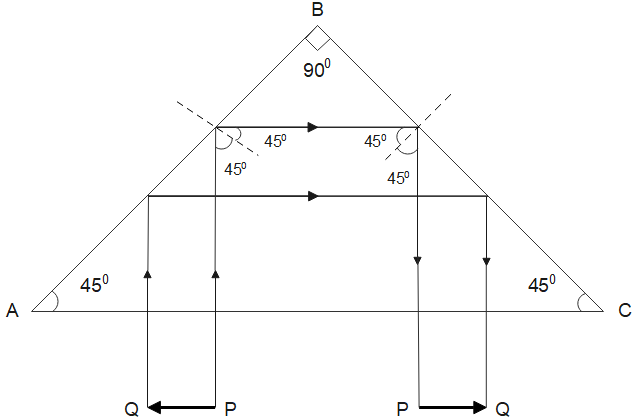
What is a total reflecting prism? State three actions that it can produce. Draw a diagram to show one action of the total reflecting prism.
Answer
538.8k+ views
Hint: A total reflecting prism is a right angled isosceles prism that has one angle equal to ${{90}^{0}}$ and other two angles equal to ${{45}^{0}}$. When light is incident normally on its faces, it suffers total internal reflection. It has many applications like it deviates light through ${{90}^{0}}$, erects an inverted image, etc.
Complete answer:
A total reflecting prism is a prism that reflects the light that falls normally on its faces, if angle of incidence is more than the critical angle (critical angle of glass is ${{42}^{0}}$), then total internal reflection takes place. It is a right angled isosceles prism that has one angle equal to ${{90}^{0}}$ and other two angles equal to ${{45}^{0}}$.
Three actions of total reflecting prism are,
1. It deviates light falling on any of its faces through ${{90}^{0}}$.
2. It deviates light falling on any of its faces through ${{180}^{0}}$.
3. It erects an image without any deviation.
The figure below shows one of the actions of the total reflecting prism, deviation of light through ${{180}^{0}}$.

The light from point P is incident normally on face AC of the prism and then falls on face AB at an angle of incidence ${{45}^{0}}$ and suffers total internal reflection as it is greater than critical angle of glass, i.e. ${{45}^{0}}\rangle {{42}^{0}}$, then again falls on face BC and suffers total internal reflection and similarly light from point Q suffers two total internal reflection and thus light is deviated through ${{180}^{0}}$.
Note:
The condition necessary for total internal reflection is that the angle of incident should be more than the critical angle of prism and value of critical angle of glass is ${{42}^{0}}$ should be kept in mind to solve prism and its applications related questions.
Complete answer:
A total reflecting prism is a prism that reflects the light that falls normally on its faces, if angle of incidence is more than the critical angle (critical angle of glass is ${{42}^{0}}$), then total internal reflection takes place. It is a right angled isosceles prism that has one angle equal to ${{90}^{0}}$ and other two angles equal to ${{45}^{0}}$.
Three actions of total reflecting prism are,
1. It deviates light falling on any of its faces through ${{90}^{0}}$.
2. It deviates light falling on any of its faces through ${{180}^{0}}$.
3. It erects an image without any deviation.
The figure below shows one of the actions of the total reflecting prism, deviation of light through ${{180}^{0}}$.

The light from point P is incident normally on face AC of the prism and then falls on face AB at an angle of incidence ${{45}^{0}}$ and suffers total internal reflection as it is greater than critical angle of glass, i.e. ${{45}^{0}}\rangle {{42}^{0}}$, then again falls on face BC and suffers total internal reflection and similarly light from point Q suffers two total internal reflection and thus light is deviated through ${{180}^{0}}$.
Note:
The condition necessary for total internal reflection is that the angle of incident should be more than the critical angle of prism and value of critical angle of glass is ${{42}^{0}}$ should be kept in mind to solve prism and its applications related questions.
Recently Updated Pages
A man running at a speed 5 ms is viewed in the side class 12 physics CBSE

The number of solutions in x in 02pi for which sqrt class 12 maths CBSE

State and explain Hardy Weinbergs Principle class 12 biology CBSE

Write any two methods of preparation of phenol Give class 12 chemistry CBSE

Which of the following statements is wrong a Amnion class 12 biology CBSE

Differentiate between action potential and resting class 12 biology CBSE

Trending doubts
What are the major means of transport Explain each class 12 social science CBSE

Which are the Top 10 Largest Countries of the World?

Draw a labelled sketch of the human eye class 12 physics CBSE

How much time does it take to bleed after eating p class 12 biology CBSE

Explain sex determination in humans with line diag class 12 biology CBSE

Explain sex determination in humans with the help of class 12 biology CBSE




